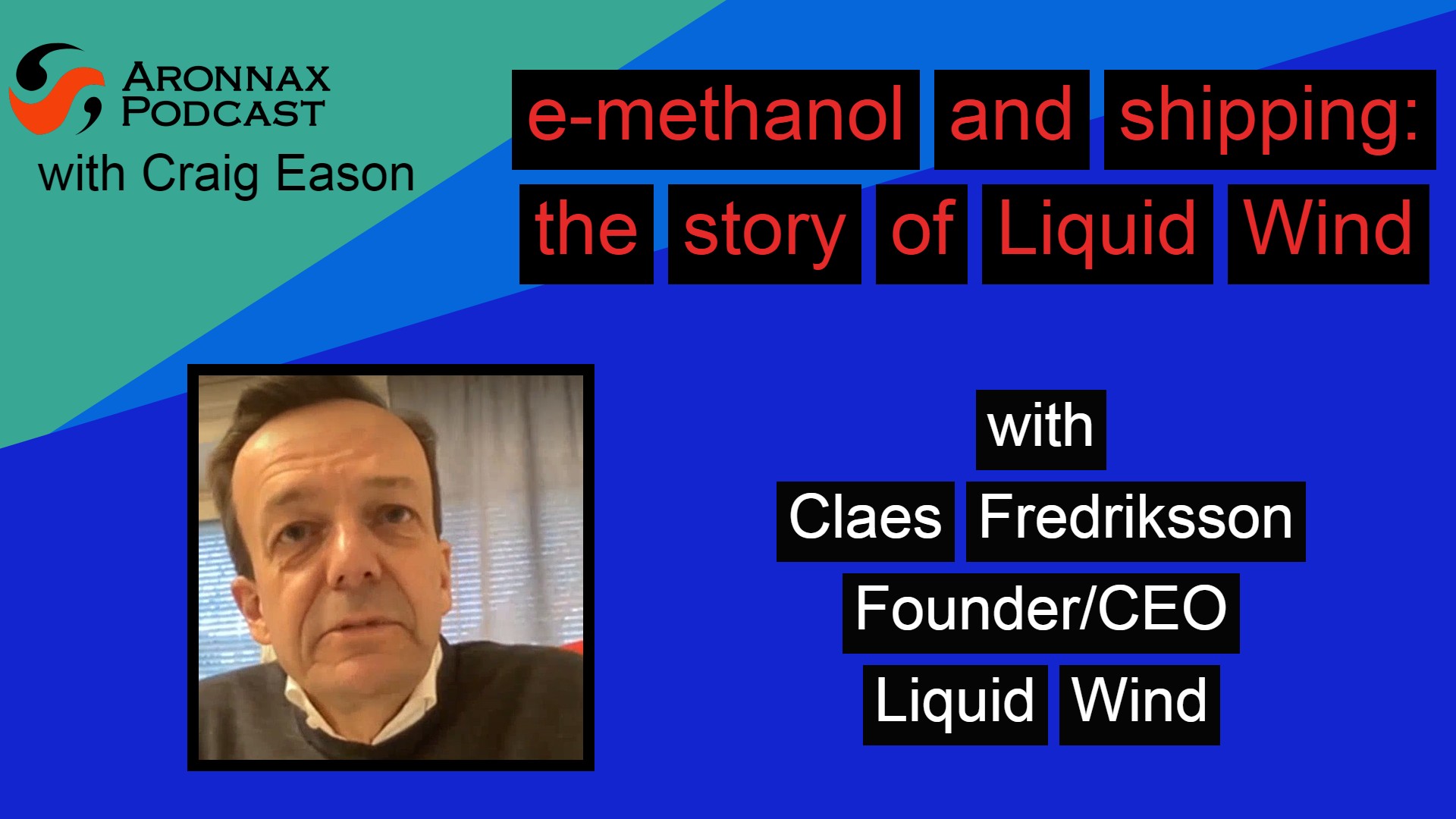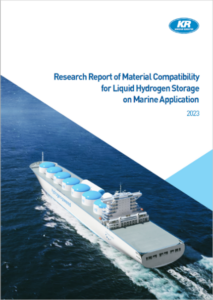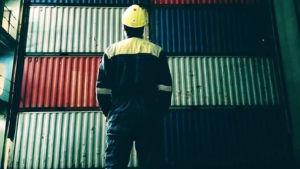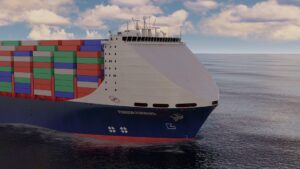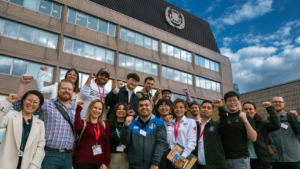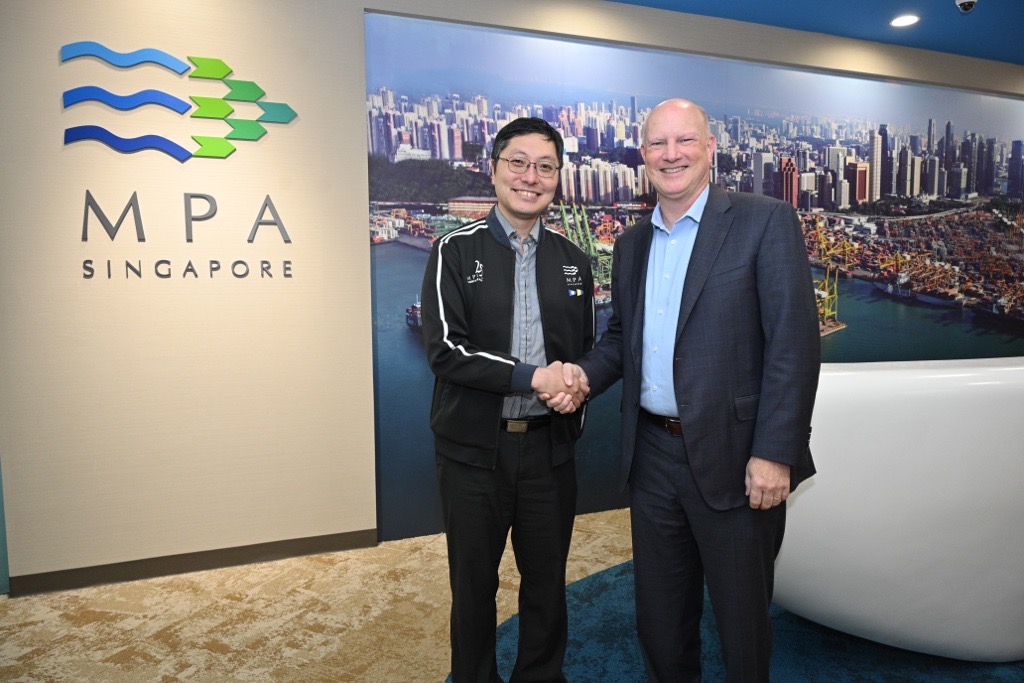Episode transcript
Hello and welcome to another edition of the Aronnax podcast the show that looks at the transition and transformation of the shipping and ocean space. I am Craig Eason, the owner and editor of Fathom World and somewhat errant podcast host.
So, hopping right in, and this week I am going to talk about e-methanol as a marine fuel, or the future of it. Methanol is a hydrocarbon fuel, and yes there are some ships using it is a fuel today. Go to Gothenburg in Sweden, watch the ferries coming in and out of the port and you will soon catch sight of Stena Germanica.
But methanol today is made mostly from fossil fuels, largely by reforming natural gas, but it can be produced differently, either using bio-products or through electrolysis and a catalytic reaction bringing hydrogen and CO2 together.
Sweden has become a focal point for methanol in recent years, not only is there the Lund University led Fastwater project which recently demonstrated how green methanol can be used to power a pilot boat for the Swedish maritime authority. And Stena took part in a project that saw methanol formed from the CO2 captured from a steel plant in Northern Sweden.
There are companies like Carbon Recycling International, CRI, in Iceland which was a partner in the steel CO2 project with Stena, there’s also Wastefuel in the US which has investment from AP Moller Maersk, Denmark’s European Energy, which through its subsidiary Reintegrate – a power to x company – has the contract to supply10,000 tonnes for Maersk’s first methanol vessel, a small 2,100 teu regional containership.
Methanex in Canada is one of, if not the largest producers of industrial methanol, and through its Waterfront Shipping subsidiary has a number of chartered in carriers already demonstrating the ability for methanol to be used as a fuel. The company was also onboard with Stena and engineering firm Wärtsilä when the Stena Germanica had its engines and fuel tanks converted to be able to run off methanol. Something like seven years ago.
Now you will find methanol given different prefixes…, grey methanol, blue methanol, green methanol, and e-methanol. But when in a ships fuel tank, they are the same molecule, and burn the same way.
IN short it refers to how the methanol is made, whether from natural gas, or from a source using carbon capture, whether from organic sources, or using electrolysis and gas reformation.
In short can the fuel be defined as having a neutral impact because the CO2 that comes out of the ships funnel can be seen as being sourced from the CO2 emissions from elsewhere such as a CHP plant, coal plant or steel mill for example, or made from organic sources, or straight form natural gas and non-renewable electricity.
The politics of production are becoming confusing, and polarised, but shipping needs to move away from the traditional distillate and residual fuels it currently uses, some million tonnes of it, and onto something different. The options for deep sea seem to be moving towards ammonia or methanol.
So, I wanted to talk to a methanol producer, or potential methanol producer, and find out their thoughts, so I turned to Claes Fredriksson, CEO and founder of Liquid Wind in Sweden.
The company has come a long way in the last six years, securing investment, equity partners and now, with a grant from a Swedish regional government to support it, the input and resources of Orsted the Danish energy company.
Liquid Wind has plans to build a facility in northeast Sweden near a combined heat and power plant, from which it will capture and use the carbon dioxide from the plant’s emissions and feed it into a catalytic methanol synthesiser along with hydrogen, the hydrogen being made through the electrolysis of water using renewable electricity from onshore wind.
This project is what Liquid Wind is calling the Flagship One project, and it is into this project that Orsted has taken a 45% stake.
I started by asking Claes about the initial seeds of interesting looking at methanol, particularly as a marine fuel.
Claes Fredriksson
We could easily see back in 2015, that this was the future, right?
Now, jokes aside, why did we do this, it’s because I have been in the clean tech space as it’s called since 2003, I started working with hydrogen purification in in Canada, selling solutions to the to the Japanese market, and actually the South American market back in the days, and then I’ve been clean tech ever since.
And what I’ve been looking for is a solution to the co2 issue. I’m not sure it’s a problem. But it’s an issue, we need to reuse the co2 in a clever way. And it was then back in 2015, I was at a conference. And somebody basically presented that not only can we, as humans make methanol from co2, and, and hydrogen, and we can make those components ourselves or create those components. It’s also a better fuel, it’s a better fuel for the engine, it’s a better fuel for the environment, because it doesn’t have the socks on the knobs. So here was sort of right in front of me what seemed to be a very good idea. And I had seen a couple of other ideas that were not as good. And I figured let’s let’s do this. It’s it’s it was that simple. It was kind of a spur of the moment decision, let’s do this. And at the time, I was consulting for a company that was looking at ways of, of securing the value of its wind. So they wanted to store a wind in something else. So I had a bit of, of sort of runway from a consulting point of view to figure out how would this actually work. And we then did a pre study with nine different companies based here primarily in Sweden, of which we have the Gothenburg energy company, one of the other local energy companies.
We had Siemens energy, we had the Research Institute of Sweden. So we had a pretty good group of people come together and say let’s look at this together. And within a year, we’ve done forever feasibility study and came out saying, this is actually a nice ad. Yeah, this can be done, if we make it big enough. And if we have the right partners to do it. And at that point, it was a matter of, okay, let’s start a company. And right there, and then all these other nine companies were in the feed pre study, they basically said, Good luck. And I stood there on my own with with the idea, which I still really like. And then I started the company. And that’s kind of our all got going.
Craig Eason
So you sort of very much in 2016, sort of stood there with a strong belief that this company, this idea is going to work. Looking on your website, I can see you’ve got a large number of companies on board, they’re all investors in the company in liquid wind as well. You have got the electrolyzers coming from the likes of Siemens Energy, you’ve got Carbon Clean, to help you with that CO2 extraction from the CHP plant. And then you’ve got how the top so with the methanol synthesis with the catalysts in the methanol synthesis, and then you got Alfa Laval providing some of the heat exchangers and I saw you’ve got unit further become an investor in the company recently, as well. So you’ve got these partners all here now able to between 2016 and 2021, you brought in the in the in these partners. So that now the biggest news is, of course, that you’ve got all stayed on board with this flagship one project. So let’s turn to flagshipOne. So you’ve got the investments, you’ve even got investments, as I saw towards the end of last year from Swedish authorities to help with the investment in that first plant in.
Claes Fredriksson
iT’s a very, very big grant from the Swedish government, which we’re very grateful for. But it’s a grant for the capital expenses into the plant. So just to be clear, we get that grant, once we have invested in the plant, then we get some money back from the from the Swedish government, that it’s the Swedish EPA.
Craig Eason
So you’re starting construction, I believe on this this plant is that this year, you’re starting construction.
Claes Fredriksson
But that’s the plan. I mean, in order to start construction, you need to have an investment decision in order to have an investment decision. When your project finance you need to have everything in place, you need to have your PPAs you need to have your offtake agreements. And and we’re now in that space where those two are the last bits we have left with, of course getting an approval on the permit, but once we have supply demand and approval permitting, then we can make that investment decision and then we will start construction. And yes, the intent is to do that during this year.
Craig Eason
Now with some what will also add to that. So are is that
Claes Fredriksson
adds the stability, and and the experiences around work. It’s more than that the confidence that we now have a real solid partner who’s executed, I think they talk about 51 projects so far. So they know how to build projects, they know how to finance projects, they know all the hurdles, you need to go through both on the regulatory and I’m on the permanent side. And for all those things they are with us so to speak, they now partner up with us as we go through the last phase of the development side of the project up to what we call fit, ready, and then fit ready stage, they have the option to buy the rest of the project, ones that they don’t own right now. And then to essentially construct or execute on building the facility. So it means that we have a partner that can not only take us through to fid but also take us beyond into construction. So it’s a really, really good thing for us. And for that to come alive. We now need to get the off taker. So someone out there has to pay us a certain premium to get this beautiful green electric fuel. And that’s what we’re looking for right now. But once we have them there, they’re able and willing to pay what we need to pay to get this first project off the ground, then then we’re essentially going to go
Craig Eason
well, that that was going to be my next question about who’s going to use the fuel. Oh, there’s there were two elements to that. One is Why do you decide that the fuel that you’re going to make would be targeted towards the shipping industry? And secondly, how far are you into those discussions? We’ve heard the likes of murder COVID started to invest heavily into into methanol fuel. And I know that some of those vessels are going to be destined for the Baltica. How are you in those discussions? Not necessarily with with MERS, I’m not saying you’re talking to Maersk, but how far are you in those discussions generally with the shipping industry to secure their commitment to a methanol as a fuel? And secondly, what’s your projections for ramping up I believe this first plant you’ve put on your website capacity is of about 70 megawatts, which will give you 50,000 tons of methanol a year. You’ve got plans for up to 10 sites, I think, or your your hope is to have 10 facilities up and running by 2030. So how do you envisage that 50,000 times and then 50,000, times 10, let’s say, to be sold into the shipping industry?
So, how far are we into shipping? We’ve been talking for shipping since we started. I mean, that’s how we started, there was a shipping conference in 2015. It was the F-Ship project, as we talked about here, and the conversion of the Germanica, the people that did the conversion, we’re very close to them, the guy who worked for Wärtsilä, when that happened, He’s on our team since the last five years. So we’re deep into the shipping space. And we’ve been following it very closely. Both because we it’s interesting, and we like it, and we think it will go first. But also, because it’s key for the financing. When we build a plant, or when we sell a plant, it’s crucial that whoever wants to invest in that plant knows that we have a buyer that is big enough to take the fuel, not only for this year, but actually for 10 years into the future. And the shipping industry is is one of the very few that we can identify that has the capacity to buy, essentially half a million tons of fuel in one shot, we’re not going to deliver in one shot, but you need to be able to make that commitment. And you did mention Maersk, I mean, they have shown that they are willing to put their money, where their mouth is and to go ahead and order 12 ships. And I think that’s been hugely helpful for the industry, that now it’s beginning to happen.
Claes Fredriksson
So the ship orders are coming in the engine manufacturers are are ready to deliver their engines. The only thing left, so to speak is the fuel-guys. And we’re a part of the fuel guyd. So we’re in a hurry to ramp up and do as much as we can. And of course, the 50,000 tonnes come out of flagship oneness is a small thing, but it just sort of whet the appetite and we want to build if it’s 10 plants, or if it’s more, we’ll see that a 50,000 ton plant is our standard building block. And then we want to multiply that so we might have a twin-plant or a triple-plant that we can build next. But the idea is to have the same design concept, the same partners doing it and simplify the engineering of the next plant as much as possible in order to keep costs down, because we’ve got to work our way down that cost curve as efficiently as we can. So, I think right now is that the next site, what we call flagship two, is likely a twin or potentially even a triple. And it will also be in Sweden, and it won’t be a very similar setup as the one we have a flagship one. But that’s the idea. And then going forward, we can have multiple triples, and why we cannot do bigger ones in Sweden is because we can get a power connection that is any bigger. To get 200 megawatts of power connection is probably as far as we can go in the locations. But we can also find the carbon dioxide. If we want to have more, we need to go somewhere completely different. And then it’s down to the desert somewhere where we put in place a huge solar plant, so we have our own power supply and then our own hydrogen production. And then we’d have to figure out another way to get the CO2 there.
Craig Eason
In terms of the shipping industry, there’s a lot of debate about the fuels that are going to be opted for. And to some extent, it’s become a discussion that’s like it’s either ammonia or it’s going to be methanol, it’s going to be one or the other. I don’t like to think like that I see it more as a as as compatible with different different elements. But I’m right in saying though, that even though methanol emits CO2 because it’s using CO2 in its production, it’s neutral. They all it’s kind of carbon neutral in terms of its overall footprint. But the other very positive thing is it’s already able to be used on the ship. It doesn’t need a complete new redesign of the ships in the way that ammonia does, and the Germanica the Stena vessel, is the proof that I as being the case, but that there are some other issues with methanol as a fuel in terms of safety aspects, but that must be a very, very positive thing that you go out there and sell it it about the the event, the ability for methanol to be used almost immediately.
Claes Fredriksson
Yeah, and the almost immediate is now been six years in the making for me, because we’ve deliberately been working on this thing to to make it happen and to make sure that we get the regulation in place, and we get people gradually more comfortable. And we’ve talking to the, to the engine companies numerous numerous times, and and they have been anything from not interested at all to sort of lukewarm. And now it’s like, Hmm, this is a good idea. And now we really want to do it. So it’s, it’s just taken some time to mature. And I think we are at the sort of, at the tipping point we talked about yesterday, we had our advisory board yesterday that we are at a tipping point, people not only want to do it, there’s also the equipment now to do it. The only only little thing left is that we need to get over that green premium hurdle. But yeah, we’re all there. And and whether it’s it’s ammonia, or it’s methanol, you can debate that forever, I think let’s just get on with it and start to produce fuel and see what happens. And I think we will likely realize that there’s so enormously big volumes of fuel that we need to produce there, it’s not going to be an either or it’s going to be everything and everyone who can please come to the party and supply because really, the targets are that we need to deliver about 30 million tons of fuel by 2030. And that’s the Maersk McKinley Center estimate if we’re going to be on the on a target to reach out 20 $50 and 30 million tons is just like phenomenally much. We think if we push the very, very hardest we can, we might be a two and a half million tonnes from liquid wind. And then there’s still Yeah, whatever that is 12 times that left that somebody else has to do. So please go and do whatever you can and let’s get get this thing going because the problem is so huge.
Craig Eason
So that was Claes Fredriksson form Liquid Wind, the Swedish e-methanol producer which has just secured Orsted, the Danish energy company. Liquid Wind has also partnered with a handful of other companies in its bid to achieve the goal of producing e-methanol for shipping. Sweden’s Alfa Laval are collaborating, as is Haldor Topsoe, which will provide the company’s catalysts to synthesis hydrogen and CO2 into the methanol, while the CO2 is captured using technology from Carbon Clean, and Siemens Energy is a partner providing the electrolysis to produce the hydrogen using renewable electricity and water.
Liquid Wind also raised €4m in a funding round last year, Uniper, a German energy group, taking a stake and becoming the second largest shareholder in the company.
Liquid Wind was not the only company making the news last week, elsewhere in the industries
Wastefuel announced its plans to produce methanol for shipping. The Us based company has AP Moller Maersk as a stakeholder; the Danish liner giant now ordering a fleet of 16,000 teu containerships that will be fuelled by methanol.
Hydrogen developments have also happened. Shell has been looking at building a hydrogen production facility in the port of Rotterdam, with a capacity for 200MW green hydrogen. While no final decision has been made, it has brought in German engineers ThyssenKrupp to help.
Norway’s TECO 2030 which is developing fuel cells has teamed up with Gen2 Energy, with an MoU, the two companies assure us the MoU will commit them to getting green hydrogen form Gen2 Energy and developing a complete hydrogen value chain.
In other news, US class society ABS and South Korea’s Hyundai Heavy Industries will work on an autonomous vessel project. There are reports an LNG carrier may be used as a demonstration.
IN the coming days the International Maritime Organizations ship design and construction subcommittee will meet and under discussion is the impact of the noise form ships on the marine environment. A set of guidelines written by the flag state and other representatives at the IO in 2014 have largely been ignored and it is widely believed in the scientific community that the noise of ships engines and the cavitation form propellers is a problem.
More details about these announcements and others can of course be found on the Fathom World website.
Visit the website on fathom dot world, and there you can subscribe to the newsletter and get news and updates and links to new podcast episodes into your in box, and of course I really would like you to share and like this podcast and follow it on whatever podcast app you like to use….
I hope to have another episode out next week, hopefully talking to two of the co-founders of Spanish wind assist developers Bound4Blue about their journey form start up to reality, and plans to become part of the transformation and transition of our ocean and maritime space
I am Craig Eason, thank you for listening, particularly right to the end, it is always appreciated (especially when feedback is so infrequent)
Until the next time
Good bye
More Aronnax episodes
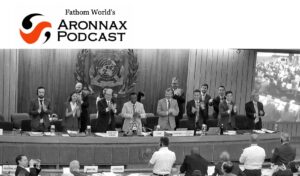

Aronnax: July 3rd
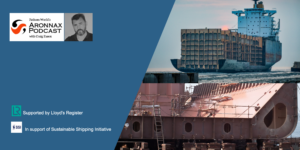
Aronnax: June 29th – Ships and their steel: Turning it green

Aronnax: June 19th

Aronnax: June 4th
























